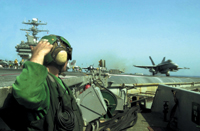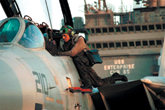Department of Defense: Internet and the Battlefield

To pinpoint the identities, strategies, habits and even locations of known and suspected terrorists, America's cyberwarriors are using Internet-derived technologies to track financial transactions, e-mail exchanges, satellite-borne transmissions and telephone records.
To pinpoint the identities, strategies, habits and even locations of known and suspected terrorists, America's cyberwarriors are using Internet-derived technologies to track financial transactions, e-mail exchanges, satellite-borne transmissions and telephone records.The military also has undertaken a more traditional exercise of power, deploying carrier battle groups, Air Force squadrons, special forces commandos, light-infantry units and combat troops. Unlike previous, large-scale engagements, however, this time commanders are better able to capitalize on the potency of information technologies. "Five years ago, people began 'Webbifying' as much as they possibly could," said Phil Dixon, regional sales manager for defense and intelligence agencies for McLean, Va.-based BMC Federal Operations, a subsidiary of BMC Software Inc. of Houston. "The Internet and related technologies have made it a lot easier and more cost-effective to get information from point A to point B. More specifically, if you can use Web-related technology, you instantly have an easier-to-deploy, easy-to-use piece of software for the warfighter."As in the ongoing, online hunt for terrorist trails and resources, Internetlike applications are being incorporated throughout combat systems as key elements in war planning and operations. Secure intranets ? combinations of dedicated servers communicating over land lines and satellite transmissions ? are enabling the military to organize, plan, communicate and execute in ways that wouldn't have been possible during the Persian Gulf War a decade ago.Browserlike software is enabling commanders to stay in touch with troops in the field. On-screen displays vividly paint the position and progress of friendly forces, replacing traditional paper maps and the plastic overlays and grease pencils that went with them. Leaders are able to more effectively and quickly coordinate joint actions, from large-scale infantry movements to naval engagements and aerial smart-weapons strikes. "Information is now available to the warfighter when the warfighter needs it, from battle plans to logistics and intelligence reports," said Doug Grice, director of business development for Army programs with Raytheon Radios/Terminals in Fort Wayne, Ind., a business unit of Raytheon Co. of Lexington, Mass. "The technology is proven and ruggedized, from radios to laptops. What's new is the software that brings all the hardware components together."State-of-the-art computer systems are at the core of the military's most advanced, deployed technology. The Army, for instance, is refining its Enhanced Position Location Reporting System, or EPLRS, a ruggedized IT system mounted on Humvees that provides a mobile, high-speed, automated data exchange.The EPLRS network can automatically reconfigure to overcome line-of-sight limitations and jamming threats, while providing information on unit identification, position and operational status. Hand-held digital radios in the field transmit information back to mobile and fixed command posts, where it is displayed on operator consoles. In turn, that consolidated information is rebroadcast to field commanders, who can display it on battle-ready laptops in preparation for maneuvers and combat.For the Navy, the Advanced Combat Direction System, or ACDS, is an automated command and control system, collecting and correlating combat information for non-Aegis surface warships, aircraft carriers and amphibious vessels. ACDS provides the capability to identify and classify targets, prioritize and conduct engagements, guide interceptor aircraft to targets, and exchange targeting information and engagement orders within battle groups.For selected cruisers, the Navy has instituted a program known as Smartship. A Smartship uses an internal local-area network to connect nontactical information related to communications, ship and damage control, engineering and navigation systems so they can be accessed from workstations, laptops, even personal digital assistants."It's a different Navy now than it was five years ago," said Hank Giffin, a retired vice admiral and former commander of the Atlantic Fleet's naval surface forces. Giffin is now vice president for strategic initiatives for Anteon Corp. of Fairfax, Va., which is assisting in the Smartship initiative.The key difference, according to Giffin, is that battle groups remain digitally connected over secure wireless networks. Ship captains can remain in constant touch with each other, significantly increasing the level of situational awareness."The Navy's mission won't be different than it was before," he said. It will still shoot Tomahawk missiles, fly airplanes and carry special forces to the battlefield. "What has changed is that these capabilities allow you to operate much more efficiently," he said.Effective operation is also secure operation. With a heavy emphasis on the reliability of information systems during combat, securing networks from attack, cyber or otherwise, must be a priority.A central goal of military planners is to prevent would-be attackers from crashing combat nets. One offering from BMC Software proposes to do just that. Its network protection application, known as Patrol, received a Defense Department "Gold Nugget" award, based on its performance during the Joint Warrior Interoperability Demonstration (JWID), held in July. JWID is a warfighting exercise run by a different military branch every two years. During the event, advanced information technologies from the private sector are assessed in a three-week, combined military exercise. This year, JWID took place at the Joint Battle Center in Suffolk, Va., at Camp Smith, Hawaii, and inside Cheyenne Mountain Operations Center, Colorado Springs, Co. Joint interoperability trials were also conducted with numerous NATO nations, as well as with Australia and New Zealand.From a single, graphical console, Patrol provides centralized monitoring and control of computer systems, detecting potential problems and threats. Patrol monitors systemwide health by continually examining and evaluating various components, including the operating system, databases, middleware, applications, network, firewalls and Internet servers.The utility can also supply historic data to predict work loads, modeling what would happen under extraordinary situations. Patrol will automatically diagnose the root cause of failures, correct them and project the change on the quality of service delivered until repair is fully effected."You have to have a way to spot and fix problems before they cascade into bigger problems in the field," said BMC's Dixon. "If a server is misbehaving, the handheld won't work. It becomes a brick. There's no help to the warfighter if he can't get information quickly and reliably."XXXSPLITXXX-Making the task of dissemination and retrieval of information more difficult are the extreme conditions of battle.In the days of the Cold War, future battlefields were presumed to be the cities, towns and countryside of Central and Eastern Europe. Such assumptions seem no longer as likely, given the nature of the new conflict with militant Islamic extremists, hidden or bunkered in mountainous regions of Afghanistan. Mobility and flexibility are key, and small-scale Internet-like applications appear the best candidate to give troops in the field the clear combat edge."Web-enabled technology is a big push right now for the Department of Defense," said David Tribble, a senior software engineer with Northrop Grumman Information Technology in Herndon, Va., a subsidiary of Northrop Grumman Corp. in Los Angeles. "They want good solutions in the field. The military wants to keep a tight view of where everybody is. But, as with everything in life, it's not easy."Making it potentially easier is Northrop Grumman's PalmELVIS, for Enhanced Link Virtual Information System, a modified version of Palm's popular handheld device. PalmELVIS provides a handheld view of tactical data with the ability to access information in stored, background databases. The device works in both connected and disconnected environments.While connected, PalmELVIS has access to the most current tactical information; when disconnected, the user can view and modify any locally loaded information and pan through maps. Changes made while disconnected are automatically loaded back to a central server when a connection is established. Information can also be shared between PalmELVIS handhelds via a built-in infrared port.The device can accept any small GIF as a map, allowing the user to access relatively complex tactical information. Users are also able to make geographically registered drawings directly on the map, make notes and mark specific points of interest.Despite the promise of such an approach, accessibility, bandwidth and security remain issues that are still being resolved. Absent robust security protocols, for example, if such a device were to fall into enemy hands, operational details could be severely compromised. There are also concerns about data overload: how much information can or should be displayed on the Palm's small screen. Data "tailoring" may thus become an important issue, Tribble said. Nevertheless, the future of tactical information may well be small, distributed, highly mobile and individually accessible, he said."There are a lot of ways to deliver data to a user in a small package over limited bandwidth," he said. "It's a matter of finding the one that will survive extreme conditions. This one is a promising candidate, but more work needs to be done."


 Battle Plans Get Internet Injection
Battle Plans Get Internet Injection



The U.S. military is using conventional forces as well as information technologies in its strikes against the Taliban regime in Afghanistan.


Internetlike applications are being incorporated throughout combat systems as key elements in war planning and operations in America's war against terrorism.
NEXT STORY: CHANNEL NEWS

